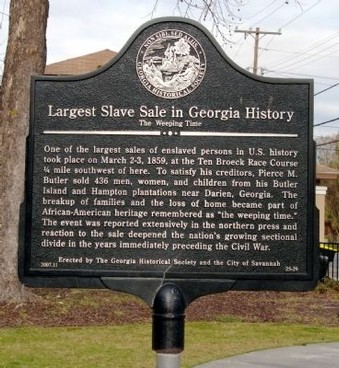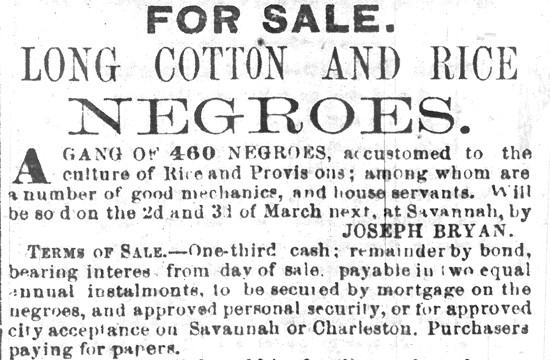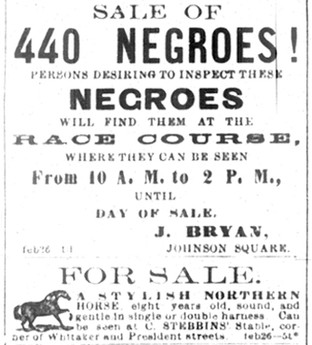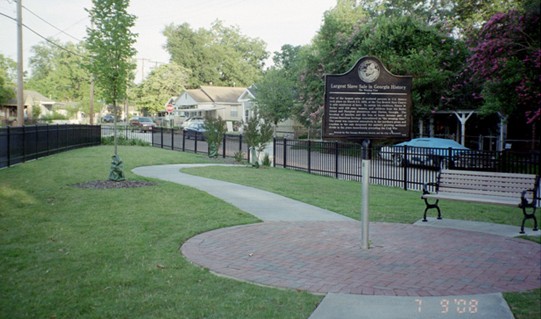The Weeping Time: Largest Slave Sale in Georgia History
Introduction
Text-to-speech Audio
Images
Slaves during the sale would fake ill when a master they did not like was inspecting them in an attempt to be bought by the kinder masters or to stay with their families.

Advertisement ran in The Savannah Republican, Tuesday, February 8, 1859.

Joseph Bryan's advertisement in The Savannah Daily Morning News, February 26, 1859.

The park containing the Weeping Time marker is one of the few historical sites that remember the slave history of the south.

Backstory and Context
Text-to-speech Audio
In 1859, Pierce Mease Butler owned 919 slaves consisting of men and women of all ages. Butler was also the owner of large amounts of debt. He liked to gamble and had lost money investing in the stock market. To recoup his losses, Butler decided to sell 436 of his slaves. He would sale all of them at once in what would be the largest slave sale in Georgia history and one of the largest in American history.
The sale took place at Ten Broeck Race Course a horse racing track in Savannah, Georgia. Butler would use a well-known slave broker, Joseph Bryan. Initially, the auction was to take place in the main city square, but it was discovered that location could not accommodate the amount of people coming as buyers. The slaves were held in horse stables leading up to the auction so that buyers could inspect them. Advertisements for the sale were ran from Monday through Saturday in the Georgian Newspapers. People came from all over the south to witness the sale and purchase human property. One newspaper wrote "For several days before the sale every hotel in Savannah was crowded with negro speculators from North and South Carolina, Virginia, Georgia, Alabama, and Louisiana, who had been attracted thither by the prospects of making good bargains. Nothing was heard for days, in the bar-rooms and public rooms, but talk of the great sale . . ."
The media covered the large event from both sides of the abolition argument. Anti-slavery newspaper writers called the auction "The Weeping Time" because of the sadness and anger it caused the slaves and because it rained for the entire duration of the sale. Reaction to the sale would be intense in the time leading up to the Civil War.
This slave auction played a large role in the eyewitness accounts of the slave trade. Pierce M. Butler's (at the time of the auction, ex) wife, Fanny Kemble, was actually an abolitionist from London. She claimed that during their marriage she was unaware of Butler's slave plantations until she visited them later on. Her visit would lead to the publication of her diaries accounting the events called: Journal of a Residence on a Georgia Plantation. The journal would become one of the most popular and detailed depictions of the true horrors happening in the American South during this period. Butler even tried to prevent its publication, using their daughters' custody status as leverage. This delay caused the diaries publication to be pushed back until after the Civil War had begun. Later on, an undercover journalist, Mortimer Thomson, would attend the actual slave auction to witness the cruelty that took place. His accounts would later be published as a sequel to Kemble's plantation accounts.
Sources
Degraft-Hanson, Kwesi. Unearthing the Weeping Time:Savannah's Ten Broeck Race Course and 1859 Slave Sale. Southern Spaces. February 18, 2010. Accessed October 11, 2018. https://southernspaces.org/2010/unearthing-weeping-time-savannahs-ten-broeck-race-course-and-1859-slave-sale.
Largest Slave Sale in Georgia History. Historical Marker Database. . Accessed October 12, 2018. https://www.hmdb.org/marker.asp?marker=15838.
The Weeping Time. PBS. . Accessed October 10, 2018. https://www.pbs.org/wgbh/aia/part4/4p2918.html.
Monroe, Kristopher. The Weeping Time A forgotten history of the largest slave auction ever on American soil , The Atlantic. July 10th 2014. Accessed August 31st 2020. https://www.theatlantic.com/business/archive/2014/07/the-weeping-time/374159/.
